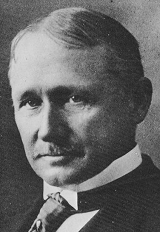Literatur |
Sekundär-Literatur |

Bildquelle: Wikipedia |
Frederick Winslow Taylor (1856-1915) kann als Erfinder der Arbeitswissenschaft oder als Erfinder des Taylorismus gesehen werden. Anstelle von Arbeitswissenschaft würde ich von Organisationswissenschaft sprechen, weil F. Taylor hauptsächlich über die Organisation des Arbeitsprozesses spricht. Er hat damit auch die Motivationspsychologie mitbegründet. F. Taylor war ein bluecolour, der sich an Abendschulen weiterbildete und sich weitgehend autodidaktisch zu seiner spezifischen Betriebswissenschaft entwickelte. Taylorismus bezeichnet eine auf ihn zurückgeführte Betriebs- oder Produktionsform, in welcher die Menschen zu Maschinen degradiert werden. Einfluss hatte Taylor nie nachweisbar, aber in der Zeit, in der er seine human gedachte Betriebsführung vorlegte, machte das Fliessband und das Akkordwesen als Produktionsform Karriere. Obwohl F. Taylor beides nicht propagierte, steht sein Name für die negativen Auswirkungen dieser Strategien.
|
Ein wunderbares Gespräch über das Verladen von Eisenbarren.
Anmerkungen / Zitate
"U.S. engineer and management consultant, originator of the concept of "scientific management" to increase worker output. Taylor grabbed public attention in the 1880s when he reduced the number of workers shovelling coal at the Bethlehem Steel Works from 500 to 140 without loss of production.
According to Taylor, industrial productivity was lower than it ought to be due to two factors: deliberate malingering by workers and unscientific design of work practices by management. He held that workers could be forced to put the maximum effort into work by a combination of motivating them with higher wages, financed on the basis of higher productivity, and most significantly, by closely monitoring the worker’s every movement so that it was impossible to go slow without detection. In order to achieve the maximum productivity, Taylor proposed that instead of reducing the number of "unproductive" workers to a minimum, about 25% of all employees should be dedicated to supervising, monitoring, measuring and accounting. This was the beginning of the stratification of the working class into more and more layers of supervisory, administrative and technical workers, enjoying privieleges over and above the "blue-collar" trades they supervised.
The symbol of Taylor’s management methods was the stop-watch, ever-present as supervisors conducted "Time and Motion Studies", timing every hand-movement, every step, every breath a worker made. Hatred against the stop watch built up to such a pitch that by 1912 laws were passed in the U.S. banning the use of stop-watches in the civil service.
Lenin studied "Taylorism" with a view to applying the progressive and genuinely scientific aspects of his theory to Soviet inudstry. (http://www.marxists.org/glossary/people/t/a.htm)
[Taylor als post-konventioneller Ingenieur]
[wp]